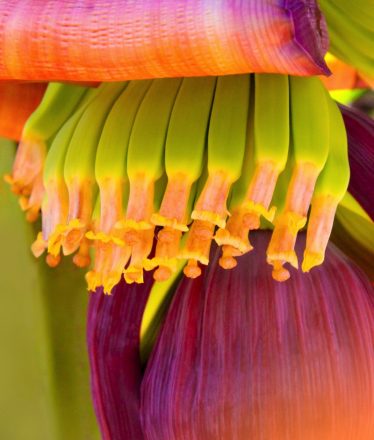Smart Key: Alternative plant-based materials The - Première Vision Paris - Denim Première Vision - Première Vision New York
Let’s unpack the secrets of sustainable fabrics through our Smart Keys. At the heart of eco-design issues, our Smart Keys series question all the available solutions to help you become more informed in your materials sourcing. Today, let’s discover alternative plant-based materials. With the agri-food industry increasingly promoting its “farm to fork” approaches, the fashion sector seems to be following in its footsteps, with an approach that could be described as from “plate to closet,” with so many innovative plant-based materials that would be typically found at the table.
Vegetizing fashion

The last five years have seen an array of fruits and vegetables used to create emerging materials:
Banana fiber from the banana plant is a popular choice to enrich the range of natural materials, and is particularly resistant.
A standard-bearer for this new generation of materials, Ananas Anam extracts the fibers in the leaves of pineapples grown for consumption, transforming them into felt that is then covered with a coating partially made from corn. Ananas Anam not only produces the material, but also uses its production residues as fertilizer or biofuel, in order to optimize every last gram of biomass.
The range of possibilities is vast, as we are now seeing materials produced from kombucha or seaweed passing the pilot project stage.
Natural composites
Mirum® combines agricultural waste such as powdered cork, coconut fiber, soybean oil and latex rubber. It contains no petrochemicals, nor synthetic binders or polyurethane coating. A clever combination of recycled agricultural by-products, this material from Natural Fiber Welding can be used for leather goods, footwear or the auto industry.
On the clothing side, Agraloop™ is a fiber-processing technology that transforms hemp, linseed, and the stems and leaves of edible and medicinal plants into artificial fibers that combine softness and eco-quality.

Mid-way between synthetics and naturals
Some solutions offer an improved version of artificial leathers made from hydrocarbons, with an increase in bio-sourced content.
These materials have a textile, cotton or polyester base, that may or may not be recycled, covered with a bio-sourced polyurethane, produced from grape marc for Vegea®, apple residues for Appleskin®, recycled corn kernels from Viridis® or cactus leaves for Desserto®. A means of pursuing research into green chemistry, using agricultural waste instead of the typical petrochemical components.
So far, the formulas are not entirely bio-sourced and are still blended with fossil fuel resources, in order to obtain materials that meet the exacting standards of the clothing and accessories industry.
Read also: Smart Key: Is polyester recycling a sustainable solution?
Root material

The innovation that is currently capturing a lot of attention lies in the root network of mushrooms. The mycelium, a fibrous network derived from the substrate of a fungal culture, can take on the appearance of felt and has the advantage of being thermosettable, shock-resistance, breathable and water repellent.
Agricultural waste or cotton cellulose act as enzymatic catalyzers for these cultures, which develop a dense mat of interconnected cells. This transformation requires specific humidity and temperature levels in order to encourage the development of these fungal mosses.
The mycelium mat can then be stabilized through a tanning process or finished with a coating produced from green chemistry, then embossed to give a grain to the finished material.
They are not a miracle solution as these materials remain at the innovation stage for now, sowing the seeds for the materials of tomorrow.
Between promising laboratory research and pilot projects, there is a long way to go before these solutions become widely available. The fashion industry will have to be patient and develop alongside these innovative technologies.
So how can we analyze the various solutions and identify the game-changing idea from the ecological damp squib?
Smart Key #1: Create an industrial symbiosis
Given that some agri-food products can generate up to 60% non-usable residue, a number of solutions are already focusing on this unexplored biomass. Some materials are already heading in the right direction, but the first requirement is to check the origin of the agricultural resources.
The possibility of creating new materials should not lead to another source of land-use pressure, with the conversion of land already dedicated to the agri-food industry, the use of GM crops or resorting to deforestation to grow plants that could be more profitable. In no way would this be a responsible operation, whether from an environmental or a social point of view.

Instead, industrial symbiosis is the name of the game, establishing collaborative networks between industries, encouraging cooperation between the agri-food and materials research sectors, with textile innovations being produced from secondary raw materials. These materials will form part of the circular economy, in order to optimize all resource use and thus reduce the ecological footprint.

Smart Key #2: Question percentages and characteristics
To describe a material as a responsible innovation, it must demonstrate a major improvement over standard alternatives, notably with regard to the percentage of biomass, the type of chemical processing (addition of solvents, plasticizers, etc.) or mechanical processing involved in its development, its breathability, water-repellent properties, and more.
Plant-based materials can often promote their biodegradability, but while this may be true of the raw material, can the same be said of the finished material? If it is truly biodegradable, then what conditions are required to achieve this?
Smart Key #3: Test resistance and durability
Often recommended to replace leather or artificial leather, these materials must primarily be chosen for their characteristics, properties or look, being selected deliberately and carefully and not by default!
Their robustness must be examined.
Physical and mechanical tests will establish the performance and durability of the material in question, with regards to its production, processing and use, by testing its tensile strength, flexibility and rub-resistance. This is in order to produce footwear or leather goods that do not repeat the cracking and wearing out that was seen in earlier generations of polyurethane or PVC products.

Sources
Comparison of the Technical Performance of Leather, Artificial Leather, and Trendy Alternatives – Michael Meyer *, Sascha Dietrich, Haiko Schulz and Anke Mondschein
Learn more about sustainability with our Smart Keys series:
- The hidden face of cotton
- Cellulosic materials
- The mysteries of chemistry
- Biodegradability
- Traceability
- Ecological and ethical accessories
- Polyester recycling
- The secrets of sports technical fabrics
- Eco-packaging
